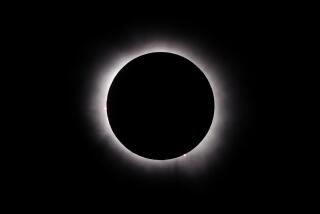Dazzling! NuSTAR captures sun’s portrait in solar X-rays
It’s time to see the sun in a whole new light – X-ray light. NASA’s NuSTAR space telescope has taken a stunning portrait of our home star in high-energy X-rays.
The related research, presented at the American Geophysical Union meeting in San Francisco this month, could offer scientists a new tool to investigate the mysterious dynamics of the sun.
NASA’s Nuclear Spectroscopic Telescope Array was launched in 2012 to study the high-energy physics of the universe, from black holes to supernovas. So when UC Santa Cruz solar physicist David Smith, a NuSTAR team member, asked lead scientist Fiona Harrison whether they could use the space telescope to observe the sun, the Caltech astrophysicist was dubious at first.
“I was quite skeptical,” Harrison said in an interview. After all, NuSTAR was meant to explore distant, high-energy targets, not the one star we can see all day long.
But Harrison soon came around to the idea, because NuSTAR could solve a long-standing mystery about the sun: How the corona, the sun’s ghostly “atmosphere,” can be heated to an average of 1.8 million degrees Fahrenheit even though the sun’s surface heats to a mere 10,800 degrees.
Scientists think that there may be tiny flares constantly popping off the sun’s surface, and that the magnetic field dynamics powering these so-called nanoflares might be what’s responsible for what’s super-heating the thin, tenuous corona.
“We want to test this theory,” Harrison said. “The theory says that if this is correct, we should see one every few minutes; if we look for hours and we don’t see any, then we can wipe out the theory.”
The sun is too bright for telescopes such as NASA’s Chandra X-ray Observatory, which probably would have been fried by all the X-rays hitting the detector. The mirrors and detectors on NuSTAR, however, have protective coverings that block out much of the onslaught. It’s somewhat analogous to eclipse glasses, which block out enough of the sun’s rays so that you can see the faint, ethereal corona around the sun without irreversibly damaging your eyes from its overwhelming glare.
“It’s just a fluke that because of the way that NuSTAR is designed … it is able to look at the sun without damaging it,” Harrison said.
The scientists looked at different wavelengths of X-ray light – the greenish hues in the image depict X-rays at energies of 2 to 3 kiloelectron volts, while the blue shades represent X-rays at 3 to 5 kiloelectron volts. These X-rays come from gas heated to about 3 million degrees. The reddish hues come from an image taken in ultraviolet light by NASA’s Solar Dynamics Observatory.
“That’s what resulted in this really beautiful image, which I think I’m going to make on my Christmas cards next year,” Harrison said.
Keep in mind, this is on the low end for the NuSTAR telescope, which can detect X-rays at energies up to 79 kiloelectron volts. The sun can put out higher energy X-rays during periods of intense activity, such as when it gives off dramatic solar flares.
For now, the sun is somewhat noisy. Harrison says they’re going to wait for a lull in the sun’s activity and try again during a quiet period, given that the nanoflares – if they exist – are probably being drowned out by the sun’s larger-scale activity.
“It could be within the next few weeks, it could be months away,” Harrison said. “It’s just kind of luck of the draw, really.”
The scientists might also be able to search for dark matter, that mysterious stuff that makes up 84.5% of all matter in the universe and yet has been only indirectly detected by its gravitational influence. Dark matter’s nature and composition are still a mystery. But if the axion theory holds, then the researchers should be able to detect a telltale X-ray pattern in the sun’s heart resulting from the axions’ interactions with the solar magnetic field.
“It’s a long shot,” Harrison said. But, she added, “if they are being produced by dark matter particles … it would be a fairly convincing signature.”
Blinded by science? Follow @aminawrite for more dispatches on outer space.







